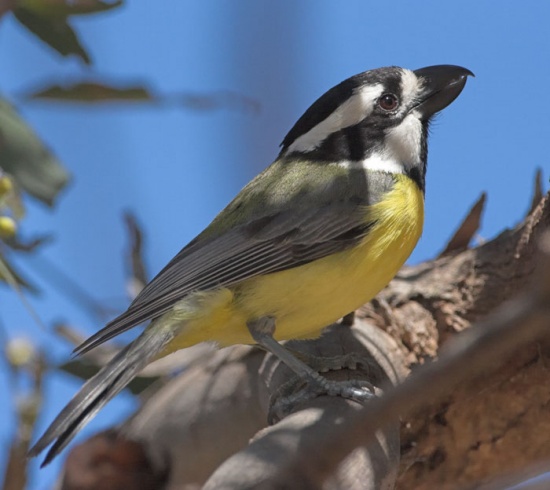- Falcunculus frontatus
Identification
16–19 cm (6¼-7½ in)
- Dull green back and wings
- Yellow belly
- Boldly marked black and white head
- Small black crest.
- Bill is unusually deep, strong and hooked
Females are similar to males but have a dark olive-green throat.
Similar Species
Western Shriketit has a white belly while Northern Shriketit is smaller and paler.
Distribution
Eastern and southern Australia: from central Queensland to southern Victoria and southeast South Australia)
Taxonomy
This is a monotypic species[1].
This species was formerly included in Crested Shriketit together with Western Shriketit and Northern Shriketit.
Habitat
Eucalyptus forests and woodlands. Also in riparian vegetation.
Behaviour
Diet
Feeds mainly on insects, takes also spiders, fruit seeds and arils. Forages in trees, taking prey from barks or foliage.
Breeding
Breeding season from August to January, usually double-brooded. The nest is a deep cup, made by the female with bark strips and dry grass. It's placed 6 - 15m high in a tree fork. Lays 2 - 3 eggs.
Nests parasitized by Pallid Cuckoo, Brush Cuckoo and Fan-tailed Cuckoo.
Resident with some local movements.
References
- Clements, J. F., T. S. Schulenberg, M. J. Iliff, T. A. Fredericks, J. A. Gerbracht, D. Lepage, S. M. Billerman, B. L. Sullivan, and C. L. Wood. 2022. The eBird/Clements checklist of Birds of the World: v2022. Downloaded from https://www.birds.cornell.edu/clementschecklist/download/
- Gill, F, D Donsker, and P Rasmussen (Eds). 2023. IOC World Bird List (v 13.1)_red. Doi 10.14344/IOC.ML.13.1. http://www.worldbirdnames.org/
Recommended Citation
- BirdForum Opus contributors. (2024) Eastern Shrike-tit. In: BirdForum, the forum for wild birds and birding. Retrieved 16 June 2024 from https://www.birdforum.net/opus/Eastern_Shrike-tit





